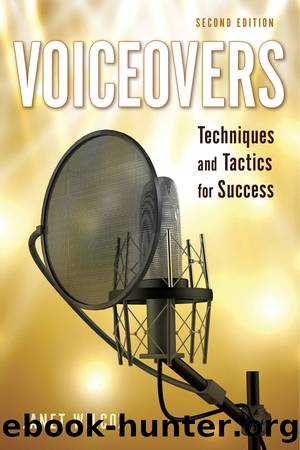Voiceovers by Janet Wilcox

Author:Janet Wilcox
Language: eng
Format: epub
Publisher: Allworth
Published: 2014-01-01T00:00:00+00:00
Technical High Hurdles
Once you are actually out there getting auditions (and booking jobs), you will have to deal with a number of different technical issues, as well as different procedures and expectations, depending upon what kind of a job you are up for, and what kind of a business is producing the job (Ad agency? Network? Animation studio?). Remember that you will perform in a booth behind glass. Donât let the isolation distract you on your first job. When the engineer asks for a sound check read with the same volume you will perform the script. Also, be courteous to the engineer because he can make you sound better or worse.
VOICE TO PICTURE
One of the techniques that you will have to master is a voice-to-picture recording. This technique may be used in a number of genres. For example, you may have to read a promo script to a temporary audio guide track and match it to the visuals of spot. Or, you may have to do ADR (automated dialogue replacement) for a character in an animation job. That is when you have to read your part and match it to the characterâs mouth movements on the screen. Veteran actor Bob Bergen describes how you do this in the booth.
Bob Bergen: âWhen doing ADR, you record one line of dialogue at a time. You watch the scene while wearing headphones. You will hear three consecutive beeps in your headphones. You begin recording on the fourth imaginary beep. This is for timing purposes. It gets you into the scene at the proper moment. So itâs âbeep, beep, beep,â act!! And itâs OK to need a couple of takes to get it right. No one is expected to be perfect in one take.â
This is an advanced technique and Iâll give you some fun exercises to play around with in the personal workout section. Basically, you have to look at a script very quickly when you receive it and then get a sense of rhythm for the visuals and the guide track and mimic that flow, all with little prep time. For example, the one-hour E! show I narrated, Hollywood & Divine, was a voice-to-picture job. I received the script right before I walked into the booth. Therefore, there was little time to rehearse and the client also gave last minute changes. The show had a rough temporary (scratch) track of the narration and sound bites of interviews in the show. I would use the scratch track and pictures to guide my pacing, and then start reading after a sound bite concluded.
This is precisely why you do a strong home workout. If you have some advance notice for this kind of work, you can record other shows from your client and transcribe them. Then do your home version of a voice-to-picture read so youâll get comfortable with the process. Youâll have to practice splitting your focus between the picture and your script. Glance at the picture for rhythm, and then learn to read smoothly without losing your place.
Download
This site does not store any files on its server. We only index and link to content provided by other sites. Please contact the content providers to delete copyright contents if any and email us, we'll remove relevant links or contents immediately.
Wonder by R.J. Palacio(8428)
Mastering Adobe Animate 2023 - Third Edition by Joseph Labrecque(3699)
Unlabel: Selling You Without Selling Out by Marc Ecko(3573)
Ogilvy on Advertising by David Ogilvy(3481)
Hidden Persuasion: 33 psychological influence techniques in advertising by Marc Andrews & Matthijs van Leeuwen & Rick van Baaren(3453)
Drawing Cutting Edge Anatomy by Christopher Hart(3437)
The Pixar Touch by David A. Price(3343)
POP by Steven Heller(3296)
The Code Book by Simon Singh(3051)
The Art of War Visualized by Jessica Hagy(2931)
Slugfest by Reed Tucker(2921)
The Curated Closet by Anuschka Rees(2895)
Rapid Viz: A New Method for the Rapid Visualization of Ideas by Kurt Hanks & Larry Belliston(2812)
Stacked Decks by The Rotenberg Collection(2795)
365 Days of Wonder by R.J. Palacio(2735)
The Wardrobe Wakeup by Lois Joy Johnson(2716)
Keep Going by Austin Kleon(2678)
Tattoo Art by Doralba Picerno(2581)
Tell Me More by Kelly Corrigan(2578)
